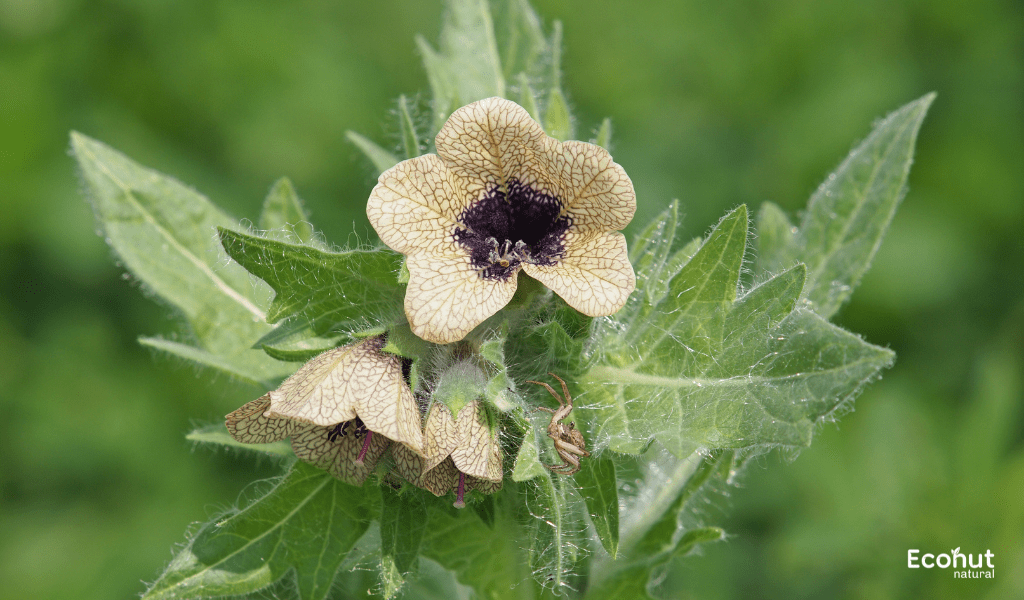Khurasani Ajwain, also known as (Hyoscyamus niger), is an annual herb that grows 30-150 cm high and is viscidly hairy and has an unpleasant odor. The plant exists in two varieties: annual and biennial. The annual reaches a height of 30 to 60 cm (1 to 2 ft) in the summer before flowering and seeding. In its first season, a biennial plant only produces a tuft of basal leaves, which wither away in the winter and leave behind a thick, fleshy root beneath.
Shadows do not allow PKhurasani Ajwain (Hyoscyamus Niger) to flourish. It needs enough sunlight to flourish properly.
Description
Biennial plants flower in the months of May and June, whereas annual plants flower best from July to September. Long yellow flowers and tassels are positioned on one side. Henbane plants can yield up to 800-1000 seeds per plant. The flowering plant’s leaves and seeds are harvested and utilized to make medications.
Botanical Name:
Hyoscyamus Niger
Family:
Solanaceae
Leaves:
The leaves have an oval or oblong form and are toothed or bluntly lobed. They feel a little sticky or hairy, and they have a dull green tint. The underside of the leaf is covered in noticeable veins.
Flowers:
Five joined petals make up the funnel-shaped blooms. Usually, they have greenish-yellow or pale yellow petals with purple veins running through them. Along the upper portion of the stalk, the flowers are grouped together.
Stems:
The hollow, erect stems are rounded in shape. They can branch out close to the top and are usually a shaggy shade of purple or green.
Habitat:
Its main habitat is Baluchistan and Afghanistan. In India, it is cultivated in the western Himalayan region from Kashmir to Kumaun. It is commonly located at an elevation of 1500–3500 meters along roadside areas. In Himachal Pradesh, it is cultivated extensively in Lahul and Kinnaur. Henbane is primarily native to Mediterranean countries and western Asia, but it is also found in many parts of Europe, Asia, and South Africa.
Parts Used:
- Seeds
- Flower is also used.
- Leaves are commonly used.
Dosage:
- Powder: 250-1000 mg
Chemical Constituents
The primary chemical components of this herb are hyoscyamine, atropine, and scopamine. Flavonoids, tannins, amines, albumin, calcium, and potassium nitrate are also found.
Sanskrit Synonyms
Yavani – From yavana Desha -Japan
Turushka – From Turkey
Parasika yavani – from Paras Country
Madakarini – Causes Mada
Other Language Names of Khurasani Ajwain, (Hyoscyamus Niger)
Bengali name – Khorasani Ajoban
Tamil name – Kurasani Yomam
Hindi name – Khurasani Ajawayan
Punjabi name – Khurasanee ajvain, Bangidewana
Urdu name – Ajvayanee Khursanee
Marathi name – Khurasanee Ova
Gujarati name – Khurasani Ajma
Sanskrit name – Parasika Yavni, Madkarini, Khurashanika, Parseekyavaani, Khurasani ajwain
English name – Henbane, Black Henbane, Common Henbane, Devil’s eye, fetid nightshade, Jupiter’s Bean
Arabian name – Altercum, Bajulbajj
Farsi name -Turumavanga
German name – Schwarzes Bilsenkraut
Kannada name – Khurasani Oma
Malayalam name – Khurasani Ova
French name – jusquiame
Scientific Classification
| Domain | Eukarya |
| Kingdom | Plantae |
| Division | Magnoliophyta |
| Class | Magnoliopsida |
| Order | Solanales |
| Family | Solanaceae |
| Genus | Hyoscyamus |
| Species | Niger |
Ayurvedic Properties
Hindi/Sanskrit
- Rasa -Tikta, Katu
- Guna -Guru,Rooksha
- Virya -Ushna
- Vipaka -Katu
English
- Taste -Pungent, Bitter
- Physical Property-Heavy,Dry
- Potency- Hot
- Metabolic Property (After Digestion)-Pungent
Khurasani Ajwain, (Hyoscyamus Niger) Uses
- Applying a paste made from seeds and alcohol to the affected areas reduces inflammation in the joints and breasts. It is an extremely helpful therapy for reducing inflammation and pain.
- Constipation can be relieved by this plant because of its carminative properties.
- A very small amount of this herb eliminates excessive heart palpitations and supports the heart.
- Stone patients can also benefit from this plant. Yavakakshar, Patha, and Guduchi are all helpful in treating stones and the pain associated with them, according to Bhavprakash Nighantu.
- This herb’s smoke has great therapeutic benefits for tooth discomfort as well.
Don’t miss: Ajwain, Yavani, Carom Seeds (Trachyspermum Ammi) Benefits, Uses, Side Effects, and More
Khurasani Ajwain, (Hyoscyamus Niger) Benefits
Digestive Relief:
Gas, bloating, and cramping are some of the symptoms of indigestion that Khurasani Ajwain may help to reduce. Additionally, it might have carminative qualities, which aid in the removal of gas from the intestines.
Respiratory Support:
Coughs and congestion may be eased by using Khurasani Ajwain (Hyoscyamus Niger). Additionally, it might have bronchodilatory effects, which ease breathing by relaxing the airways.
Pain Relief:
Discomfort relief from headaches, joint discomfort, and toothaches may be facilitated by using Khurasani Ajwain. Additionally, it might have anti-inflammatory qualities.
Anxiety Relief:
Khurasani Ajwain may aid in relaxation and anxiety reduction.
Khurasani Ajwain, (Hyoscyamus Niger) Side Effects
Digestive Issues:
Because Khurasani Ajwain stimulates stomach secretions, it may exacerbate illnesses like ulcers. Constipation, nausea, and vomiting can result from overindulgence.
Skin Irritation:
Some folks get skin irritation right away.
Headaches:
It can cause headaches in certain people.
Avoid During Pregnancy and Breastfeeding:
Nursing babies and unborn children may be harmed by khurasani ajwain.
Conclusion
Black henbane is well-known for treating neuralgia and Parkinson’s illness. Both respiratory and spasmodic digestive diseases can benefit from the use of Khurasani Ajwain. Additionally, it relieves rheumatic, arthritic, and sciatica symptoms.
FAQS
What is Khurasani ajwain used for?
Through increasing metabolism, enhancing digestion, and reducing acidity, it may aid in and encourage weight loss. Ajwain has an appetizing (Deepan) characteristic that may aid in the management of digestive issues by stimulating digestive fire. It might also aid in lowering cholesterol and combat bacteria.
What is Khurasani ajwain called in English?
Black Henbane
What are the benefits of khurasani ajwain?
Through increasing metabolism, enhancing digestion, and reducing acidity, it may aid in and encourage weight loss. Ajwain has an appetizing (Deepan) characteristic that may aid in the management of digestive issues by stimulating digestive fire. It might also aid in lowering cholesterol and combat bacteria.
What are Hyoscyamus niger’s side effects?
When henbane is used, common side effects include flushed skin, narcosis, dilated pupils, and hallucinations. Ataxia, hypertension, convulsions, tachycardia, vomiting, and hyperpyrexia are less frequent side effects. While aftereffects can linger up to three days, initial effects usually last three to four hours.

